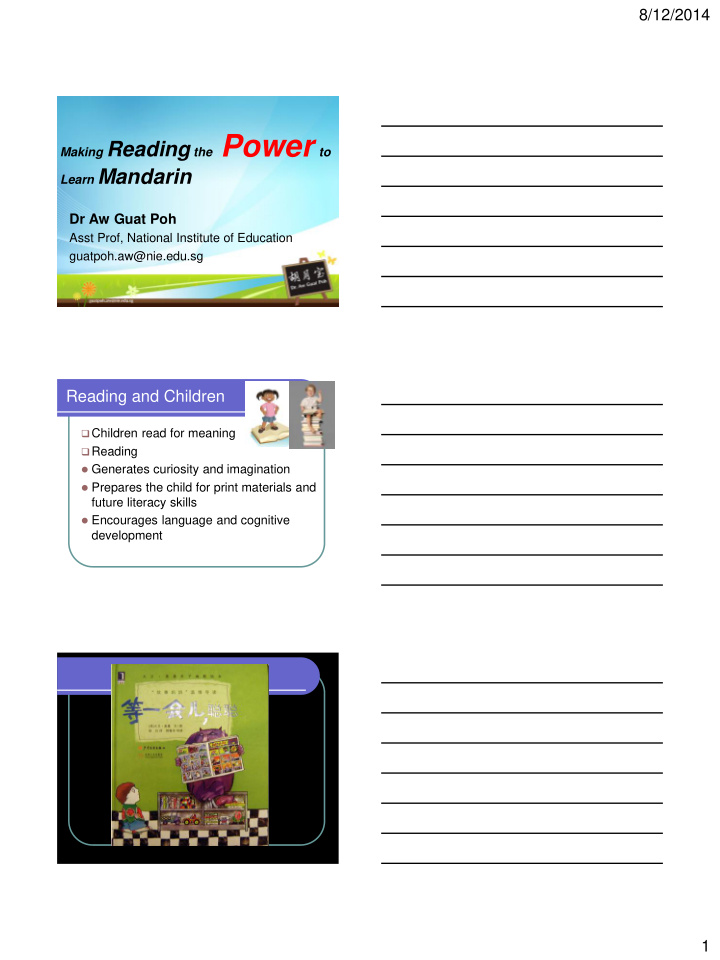



8/12/2014 Making Reading the Power to Learn Mandarin Dr Aw Guat Poh Asst Prof, National Institute of Education guatpoh.aw@nie.edu.sg Reading and Children Children read for meaning Reading Generates curiosity and imagination Prepares the child for print materials and future literacy skills Encourages language and cognitive development 1
8/12/2014 Family Reading Promotes affectionate time between parents and child Shares the pleasure of reading Provides opportunities of communication between parents and child I HATE CHINESE !!! Second Language Learning Challenges faced by L2 Learners Affective Filter Motivation, self-confidence vs. effective learning Acquisition-Learning + Monitor Acquiring and learning a language; monitoring one’s learning Input + Natural Order Language environment for inputs; Understanding the form of a language (Krasten's hypotheses) 2
8/12/2014 Second Language Reading Procedures for L2 Reading Decode Input Encode Output (Reading) (Comprehend) (To Express) (Switch) L2→L1 L1→ L2 L2 L2 L2: Second Language L1: First Language What can I do ? Parents, YOU are important! Mentor Role of Parents FM3 3
8/12/2014 Role of Parents Facilitator to select suitable books to read the book first to identify challenging vocabulary; to identify main language points; Role of Parents Motivator To alleviate affective filter: To motivate To provide encouragement ( lots! ) To help to boost child’s self -confidence Motivator (Krasten's hypotheses) Role of Parents Monitor To monitor the reading process and provide guidance when necessary 4
8/12/2014 Role of Parents Mentor Be a reader yourself to set good example To inculcate the good habit of reading To be able to discuss questions raised during reading or post reading Mentor Factors to consider when choosing children’s books Age Gender Group Individual Language Interest Choose books to suit age groups 5 year-olds: 《小象阿福》 respond to physical and psychological characteristics; perceives themselves as heroes, believes that physical strength is the ultimate truth. 10 year-olds: 《点》 respond to honesty, responsibility and justice; focus on “good boy/girl” role models. (Liu Lan: Master Classes of Leadership) 5
8/12/2014 Characteristics of Male readers Visual spatial Books with illustrations Technology E-books, reading online http://www.qbaobei.com/html/story/tstory /index.htm Facts and information books about history, science and technology. 《求助 犬》 Competitiveness read along with siblings Individual Interest Tap on readers’ prior knowledge and life experience Animals-related stories Problems-solving stories Funny stories 《谁在我的头上嗯嗯》 Avoid stories with direct moral ethics message 《鳄鱼怕怕》 Language Comprehensible Repetitive sentence structures (Lower) Continuous content Suitable font size for different age groups Sufficient illustrations 6
8/12/2014 Guidelines for choosing the right books Interesting, humorous, imaginative Prior knowledge/experience Authentic materials — content and language — local settings 怕什么 Good illustrations d ì w ǔ g è d à w è i b ù k ě y ǐ 第 五 个 大 卫 不 可 以 sh ǔ xi ǎ o d ì de l ǐ w ù w ū p ó y ǔ m ā o 鼠 小 弟 的 礼 物 巫 婆 与 猫 HOW to read ? Reading Process Pre-reading Tools: Dictionary, a selection of suitable books for child to choose from Preparation: Parents to read the book first for challenging vocabulary; identify the main language points; discuss some aspects of the book first before reading Mentality: Unconditional reading (read only for interest); the same book could be read again and again 7
8/12/2014 Reading Process Pre-reading Parents’ company: to alleviate affective filter, (to help to boost self-confidence for young children), to explain contents of the book when necessary, to get child to explain/elaborate. Reading Process Post-reading Activities/games: related to the story (need not be language-based), re-write, Q & A, pyramid game etc. Repetitive reading: reading the same book over and over again. (Lower) Presentation: drama, finger puppets, voice- recording (Lower) Sharing and Discussion: feelings about the protagonists/story (Upper) Reading Process Post-reading Librarys/bookshops: frequent visits to library and bookshops to inculcate long-term reading habits. Examples: 1) 友谊企业有限公司 ( Friendship Bookstore) (Bras Basah Complex, #03-07/11 ) 2) Popular Bookshop 3) Kinokuniya Bookshop (391b Orchard Road #13-06 Ngee Ann City Tower B) 8
8/12/2014 Reading Process During reading Cultivate 3 Good Reading Habits: To infer from given illustrations; to deduce LOOK from the forms of Chinese characters; to infer from the rest of the paragraph. Think about the words that you have learnt or you THINK have heard. ASK To ask a someone or to “ask” a dictionary. Guidelines for family reading Yes! No! Take your Rush through time Read for Lecturing/ entertainment Punishment Read for Read for quality quantity Allow games Solemn and fun reading Conclusion: Key points for Lower Primary Reading Select picture books with good text and illustrations Read with them Parents can read aloud to children and vary reading styles (read straight from text; talk about the illustrations; tell the story with no reading) Challenge children’s imagination with questions and guide them to infer from illustrations or use guided questions Read their favourite books over and over again. 9
8/12/2014 Thank you abaolaoshi@gmail.com 10
Recommend
More recommend